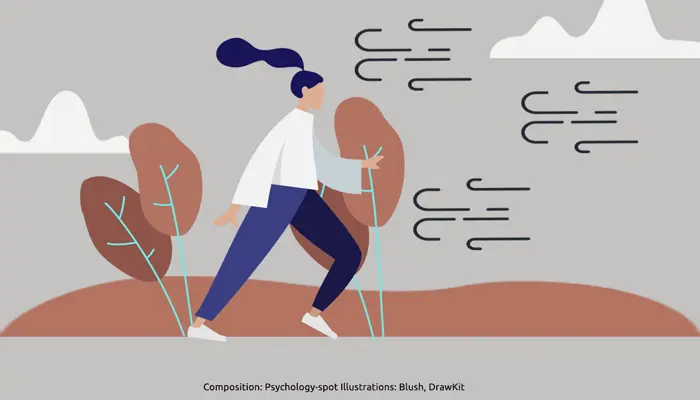
Resilience is the ability to face adversity without breaking down and even coming out of it strengthened, with a renewed confidence in our potential to deal with the future. Undoubtedly, it is an essential skill for life since it not only allows us to deal with problems and conflicts with less stress, but also reduces the level of anguish and discomfort allowing us to maintain a basal level of functioning.
Psychologists have spent years analyzing the behaviors of resilient people to find common ground. They have discovered a series of characteristics of resilient people that allow them to better cope with adversity. It is a combination of social and problem-solving skills, as well as emotional self-management and projection into the future that allow them to deal with problems with greater integrity and find their strength in the midst of the storm.
What characterizes a resilient person?
1. Feeling of self-efficacy. Resilience arises, to a large extent, from security and confidence in our abilities to solve problems. In fact, people who have suffered major trauma and have been able to overcome it on their own, are more likely to successfully face future problems and find the tools to solve them, because they are more confident in their ability to cope.
2. Deep self-knowledge. A resilient person is not a naive optimist, but rather has a fairly objective image of himself. He knows his strengths and potentials, as well as his weaknesses and shortcomings. This allows him to compensate for his weak points to better cope with adversity.
3. Locus of control internal. It is the tendency to interpret the results as a direct consequence of our actions, so that they are under our control, instead of thinking that they are due to external forces. This locus of control internal helps the resilient person to take charge of his life even in the worst moments and take responsibility for his decisions.
4. Creativity and intuition. Resilient people also use creativity to solve problems and conflicts. They are able to adopt different points of view and find new ideas that lead to original solutions. Often this also means following the commands of intuition and having imagination, especially in stressful situations.
5. Flexibility. It is the ability to adapt to different contexts and interlocutors without losing our identity. Resilient people are flexible like reed, instead of showing the iron resistance of oak, which allows them to flow better when things go wrong. They are capable of adapting to circumstances, but without losing their essence.
6. Sense of humor. It is the ability to keep a smile even in the midst of adversity and put a good face on bad weather. A resilient person will be able to face problems with a sense of humor and, above all, they will be able to laugh at themselves, a skill that helps them de-dramatize and even assume a psychological distance from the situation.
7. Optimistic projection into the future. Resilience doesn’t mean wearing pink glasses. We realize the problems and understand their complexity and impact, but even so, we may be able to set new goals for the future and, above all, find the most appropriate strategies to achieve them. A resilient person knows that, no matter how dark his present, the sun can shine again in his future.
8. Communication skills. One of the characteristics of resilient people is that they are able to connect with others and ask for help. They do not generate pity, but they know how to express their feelings and emotions, so that others perceive that vulnerability and are more willing to help them. This allows them to build a solid support network to face the most difficult moments.
9. Realistic expectations. Resilient people are realistic. They don’t ask the elm for pears. They are able to estimate with some objectivity the possibility that certain events will be fulfilled, so that they can establish valid plans for the future and minimize the chances of experiencing frustration.
10. Internal motivation. Resilience involves, in large part, being able to find the right stimuli to act and move on when everything seems to be working against us. Resilient people find the strength and reasons to fight within themselves, so they are less dependent on external changes.
11. Perseverance. One of the characteristics of resilient people is that they are able to persist to achieve their goals, despite setbacks. In fact, the obstacles become a challenge that prompts them to continue. These people do not understand problems as pitfalls on the road but rather as challenges to solve.
12. Eagerness to excel. Another characteristic of resilient people is their desire to constantly improve, grow and perfect the skills they have acquired. They are not people who are easily content, but who always try to go one step further to expand their limits and get out of their comfort zone. That attitude positively predisposes them to face problems.
13. Clear objectives. “There is no favorable wind for the ship that does not know where it is going”, Seneca said centuries ago. Having a clear destination is particularly important in stormy times because it allows us to focus on that goal. That is why resilient people always keep their dreams and goals in mind. They are aware that the path can be changed or lengthened, but not the destination they wish to reach. That gives them enormous strength to avoid obstacles.
14. Coherence. Resilient people are often coherent. They know what they want and make decisions to get there. They are clear about their meaning in life and, instead of being carried away, they stay the course by aligning themselves with their values and dreams. They are independent people who act according to their codes, without being overly conditioned by others.
15. Generate changes. Resilience is not just an attitude, it is also a behavior. Resilient people are able to recognize their functional and dysfunctional behaviors to apply the necessary changes and find effective solutions. While others are left crying over spilled milk or falling into victimhood, a resilient person will rush to put the broken pieces back together.



